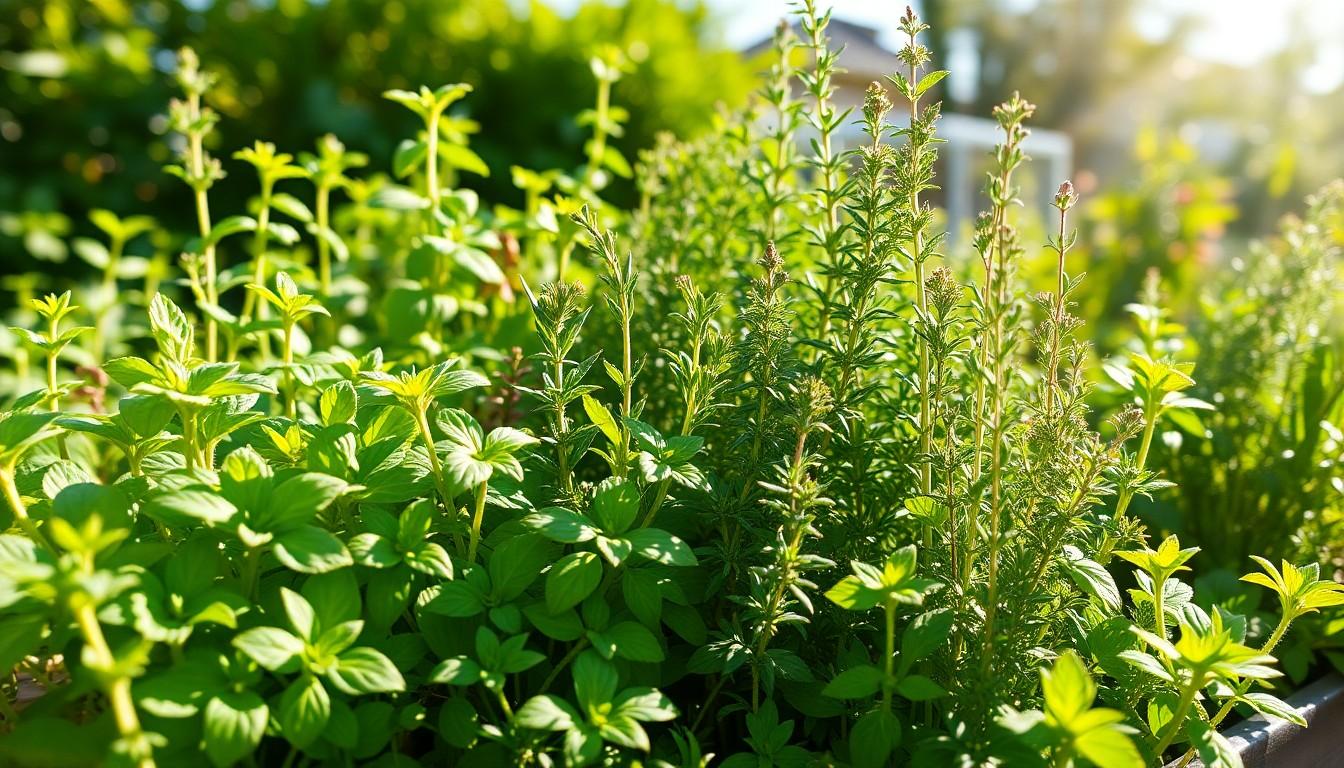Imagine stepping into your kitchen and being greeted by the fresh aroma of basil, mint, and rosemary. Cultivating herbs isn’t just for the green-thumbed elite; it’s for anyone who craves a sprinkle of flavor and a dash of joy in their meals. Whether you’re a culinary novice or a seasoned chef, growing your own herbs can transform your cooking and impress your dinner guests.
How to Cultivate Herbs
Herbs offer numerous culinary and health advantages. Culinary herbs like basil, mint, and rosemary enhance flavors in various dishes. These fresh ingredients provide vibrant aromas and elevate meals to new heights. Nutritionally, many herbs contain essential vitamins and antioxidants, contributing to overall well-being.
They contribute to flavor without adding calories, making them ideal for healthy cooking. For instance, basil is rich in vitamin K, supporting bone health. Mint aids digestion and adds a refreshing note to beverages and desserts. Rosemary possesses anti-inflammatory properties, which benefit cognitive function.
Herb cultivation also promotes wellness beyond the kitchen. Maintaining a herb garden can reduce stress and improve mood. Engaging with plants encourages mindfulness and fosters a connection with nature. Additionally, homegrown herbs provide convenience, as they are accessible for immediate use in recipes.
Herbs are versatile in their uses, ranging from culinary applications to natural remedies. Rosemary can work as a natural preservative, while parsley is a great source of iron. Each herb brings unique characteristics that can transform an ordinary dish into something extraordinary. Embracing herbs isn’t just about enhancing flavors, but also about enriching everyday life.
Understanding herbs and their benefits allows anyone to appreciate the art of cooking more fully. The allure of using fresh ingredients ensures meals become memorable experiences, impressing both family and friends. Thus, cultivating herbs becomes a rewarding endeavor in every kitchen.
Choosing the Right Herbs

Choosing the right herbs enhances the flavor and appeal of home-cooked meals. Consider selecting herbs that align with culinary preferences and growing conditions.
Popular Culinary Herbs
Basil, mint, and rosemary rank among the most popular culinary herbs. Basil, rich in flavor, pairs well with tomatoes and is essential in Mediterranean dishes. Mint, known for its refreshing taste, adds a lively touch to salads and beverages. Rosemary, with its robust aroma, complements roasted meats and vegetables. Other favorites include thyme, oregano, and parsley, offering unique flavors that elevate dishes. Opting for a variety ensures a well-rounded herb garden ready to enhance various recipes.
Medicinal Herbs
Herbs also play vital roles beyond the kitchen. Chamomile aids in relaxation and supports better sleep, while echinacea boosts the immune system. Turmeric, known for its anti-inflammatory properties, benefits general health. Additionally, ginger alleviates digestive discomfort and nausea. Selecting medicinal herbs tailored to specific needs promotes well-being alongside culinary uses. Maintaining a diverse herb collection maximizes benefits for both health and cooking, fostering a deeper connection with the natural world.
Preparing for Herb Cultivation
Preparing for herb cultivation involves careful planning and consideration. Selecting suitable herbs and their ideal environments contributes to a flourishing garden.
Selecting the Right Location
Choosing the right location for herb cultivation ensures optimal growth. Sunlight plays a vital role, so selecting a spot that receives 6 to 8 hours of direct sunlight daily maximizes photosynthesis. Accessibility is also important; positioning herbs near the kitchen eases harvesting and enhances convenience. Protection from strong winds prevents damage and maintains moisture levels in the soil. Additionally, considering drainage will help avoid waterlogging, which can hinder root development. Evaluating these factors leads to a successful herb garden that thrives and flourishes.
Soil Requirements and Preparation
Soil quality directly affects herb growth. Herbs generally prefer well-draining, fertile soil rich in organic matter. Testing the soil pH reveals that most herbs thrive in a range of 6.0 to 7.0. Amending soil with compost or aged manure improves nutrient content; this step ensures robust plant development. Tilling the soil enhances airflow and drainage, promoting healthy root expansion. Removing rocks and debris creates an inviting environment for plant roots, allowing herbs to establish themselves effectively. Observing these soil requirements and preparation techniques guarantees a strong foundation for herb cultivation.
Planting Herbs
Planting herbs requires consideration of methods. Seeding and transplanting form the two primary approaches for starting an herb garden.
Seeding vs. Transplanting
Seeding requires planting herb seeds directly in the soil. This method offers a cost-effective way to grow a wider variety of herbs. Transplanting involves moving established seedlings into the garden, which allows for quicker growth. While both techniques yield successful results, seeding takes longer to produce harvestable herbs, requiring patience. For those eager for quicker results, transplanting provides a viable option to enjoy fresh herbs sooner.
Optimal Planting Techniques
Optimal techniques exist to ensure herbs thrive. Begin by spacing plants at least 12 to 24 inches apart, allowing for adequate airflow. Proper soil depth contributes significantly; a depth of 6 to 12 inches promotes healthy root systems. Water gently after planting; consistent moisture supports initial growth. Providing a sturdy support system, such as cages for taller herbs, helps prevent drooping. Regularly monitoring light exposure ensures that herbs receive the necessary 6 to 8 hours of sunlight daily.
Caring for Your Herbs
Caring for herbs involves regular attention to their needs for optimal growth and health.
Watering and Fertilizing
Water herbs deeply once the top inch of soil dries. Herbs generally prefer moist soil but don’t thrive in waterlogged conditions. A consistent watering schedule promotes robust root development. Fertilize every four to six weeks during the growing season with a balanced, organic fertilizer. Organic options, like compost tea or fish emulsion, enhance nutrient levels without harming the plants. Always dilute fertilizers to prevent root burn, using half the recommended strength. Monitor growth; if leaves appear pale or yellow, consider adjusting fertilization frequency or potency. Proper care ensures herbs flourish and provide abundant harvests.
Pests and Diseases Management
Inspect herbs regularly for common pests like aphids, spider mites, and whiteflies. Encourage beneficial insects, including ladybugs that naturally control pest populations. Use insecticidal soap as a safe option for treating infestations. Monitor humidity levels; excessive moisture can lead to diseases like powdery mildew. Prune infected leaves promptly to prevent spread. Ensure proper airflow around plants; spacing them adequately reduces the risk of fungal diseases. Regularly removing debris from the soil also helps eliminate habitats for pests. Taking proactive measures keeps herbs healthy and promotes a thriving kitchen garden.
Harvesting and Storing Herbs
Harvesting herbs at the right time ensures maximum flavor and potency. Look for signs of maturity before cutting, such as vibrant leaves and strong scents. Regular cutting encourages bushier growth and more abundant yields. Use clean, sharp scissors or pruning shears to minimize damage.
Best Practices for Harvesting
Harvesting during the morning, soon after dew evaporates, captures the best flavors. Cutting back just above a leaf node fosters new growth, while leaving some foliage intact helps maintain the plant’s health. Focus on mature, sturdy leaves, as these contain the most essential oils. Frequent harvests allow for a continuous supply throughout the growing season.
Techniques for Drying and Storing
Drying herbs preserves their flavor for long-term use. Air drying works well for hardy herbs like thyme and rosemary; simply hang them upside down in a cool, dark place. For delicate herbs, like basil and parsley, using a dehydrator or an oven at low temperatures prevents wilting. Store dried herbs in airtight containers, away from light and moisture. Label containers with the herb name and harvest date for easy reference.
Transform Everyday Cooking into a Delightful Adventure
Cultivating herbs offers a rewarding experience that elevates both cooking and well-being. By nurturing these plants, individuals not only enhance their meals but also foster a deeper connection to nature. Whether it’s the aromatic basil or the refreshing mint, each herb brings unique flavors and health benefits to the table.
With the right planning and care, anyone can successfully grow their own herb garden. Regular attention to watering, sunlight, and soil will lead to a bountiful harvest. As they embrace this journey, individuals will find joy in the process of growing and using fresh herbs, transforming everyday cooking into a delightful adventure.

